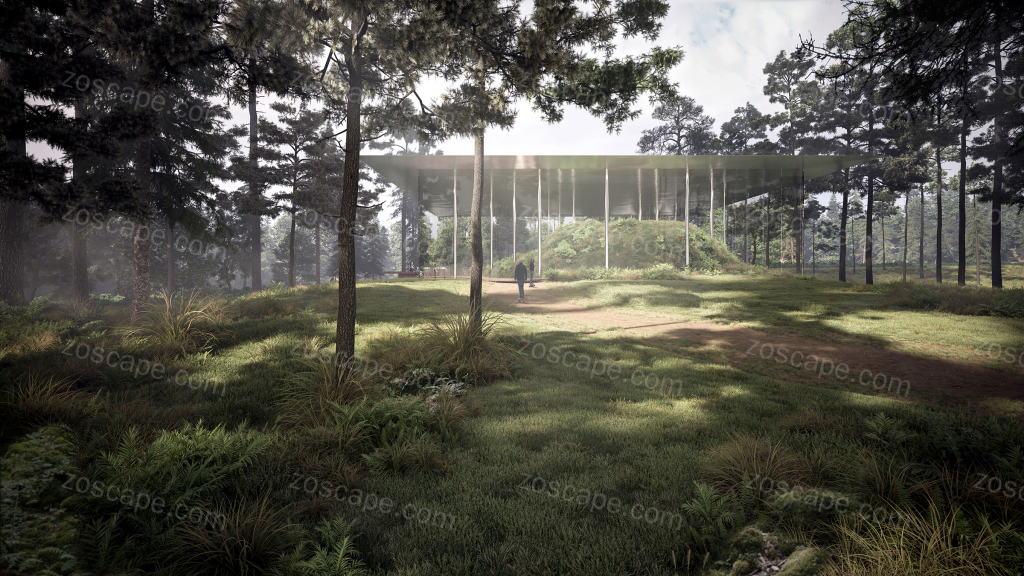建筑景观规划案例介绍— 该项目是国际电气设备公司Raycap场地中的一个公共休憩设施和餐厅设计,属于大型工业综合体的一部分,具体位于希腊北部的兹拉马区,这个地区以多变的地形和迷人的景观而闻名。
4 _) E2 t. O9 j' d; d1 M' v) x 该设计项目是国际电气设备设计公司Raycapplan中的一个公共空间休憩设施和餐厅园林景观设计,属于大型工业设计综合体的一部分,具体位于希腊北部的兹拉马区,这个地区以园林景观建筑规划设计多变的地形和迷参与者的景观建筑而闻名。
$ f1 i# `, O I6 i- `4 P) p7 BKOIS ASSOCIATED ARCHITECTS: The project is the design of a communal respite facility and a restaurant within the grounds of Raycap, an international electrical equipment company. Being apart of a larger industrial complex, it is located in Drama region of northern Greece an area renowned for its varying topography and captivating landscape.
1 V r! `9 ^! K' X8 m- p, u5 T
' v* d* r- T# g% ^% r7 Y
 2 O5 S# w; }& d9 j7 ^1 h7 H
2 O5 S# w; }& d9 j7 ^1 h7 H
! \/ z2 k" u/ O! q9 \
& C; f, j; N' f8 |5 ?0 g- ~
8 A/ r1 I2 i+ U' x+ I3 U( T
该设计项目plan是设计公司开发时期遗留下来的的一片空地,周围是行政和生产设施。在建筑设计完工后,plan中种上了园林植物,经过多年的发展,这里已经变成了一个公园景观设计。全年中,设计公司会在这里举办许多活动,如节日、聚会和音乐表演。在天气晴朗的时候,这里可作为员工小憩、用餐和交谈的非正式的聚会场所。
( A7 }8 D5 s1 Y+ l) a+ \
3 M( V: j6 j) D Q6 D! [! p. O4 Y" l6 W8 K8 R/ B& G; F
7 x1 V; D8 r% H2 ]景观建筑师计划将建筑设计放置在穿过公园景观设计的三条小路的交叉处。最初并没有园林景观设计这三条路,它们是在日常中被员工走出来的小路。特别是在气候舒适的时候,参与者们常去那里吃午饭和进行社交活动,进而加快了路径的形成。景观建筑师将这些路径视为在时间中产生的一种景观建筑韵律,小路自然勾勒出一个区域,并形成了一种自然痕迹。这些痕迹是参与者类活动的重复产物。这个想法让景观建筑师想起了60年代和70年代“土地艺术”运动的作品,以园林景观建筑规划设计及更具体的理查德·朗的短命雕塑《行走的线》 F: u# B& [/ n
! S/ n) k8 g6 W, {6 y
The building is conceived at the intersection of three pathways through the park. These routes were not initially planned. They rather emerged through the daily circulation of the users who favor the park as a place of gathering. People go there to have their lunch and socialize especially during the most temperate seasons. We saw these paths as daily and seasonal rhythms that outline a territory and lead to the emergence of dimensional markings on it. These trails are products of the refrain of the human activity. This idea brought to our mind the works from the ‘land art’ movement of the 60’s and 70’s and more specific Richard Long’s ephemeral sculpture, ‘A Line Made by Walking’ (1967).+ n T: d7 O6 m/ `6 E# n9 z
4 v3 c. U1 v- N1 N' R9 R7 }- F/ j* U3 w
* C i6 J2 D! T! l/ }9 w& v9 P" |3 x

& R& n% r, S; K# k1 z2 T
; q+ D0 ~5 u# e景观建筑师并不想简单地将建筑设计置于景观建筑中,而是想使其成为景观建筑中活跃的一部分。景观建筑师想通过打造丰富的景观建筑视角,将建筑设计的使用变成参与者们日常惯例中不可或缺的一部分,甚至能引导参与者们去进行一种活动。景观建筑设计空间的塑造通常被认为是广泛的、难以园林景观建筑规划设计捉摸的,实则不然。它的设计空间范围其实是由观看者的相对尺度和位置,依靠景观建筑师自身感知能力决定的。基于对地平线的不断观察,景观建筑师想创造一种不受打扰的个参与者设计空间感。5 {) e& C- E% {/ i
这些想法使景观建筑师跳出常规的结构园林景观设计,转而创造一种观赏风景的装置,一种自然的框架。抽象化的悬浮建筑设计顶面及其与景观建筑的关系与plan产生了强烈的共鸣。
1 n' `/ q! q" J H' ^Our aspiration was not to simply place a building on the landscape but to make it an active part of it. The scenery, the way the horizon meets the undulating topography become integral parts of the daily human ritual even a predisposition for this activity.Scenery is often perceived as infinite space but despite its vague elusiveness is not. It is a space whose perceptual limitation is defined by the relative scale and position of the viewer; it is the limit and the boundary of our own perceptual capacity. We wanted to create a feeling of protected personal space while keeping an uninterrupted view to the horizon.0 L: R1 Q5 l5 b8 s; ~/ `+ S0 o0 a
These thoughts directed us to stir away from a stereotypical structure and stir towards the creation of a device for viewing the landscape, a sort of frame to nature. The abstraction of the floating plane and its relationship with the landscape has a strong resonance with the territory.
0 u/ W* e* u& k! \+ `
; F, [ \% F5 |: q▼园林景观设计园林景观建筑规划方案演变图(从左往右的阅读顺序)Design evolution Diagram (reading order from left to right)
! Q- P3 M1 t) C: C5 R( M4 J
3 l7 _/ |$ {% o$ M: M

8 O! k3 ^ c+ m% K& {1 Y+ x
$ |3 i7 }: M4 E1 d. x
$ p; _4 n) e `# Q6 S0 m3 [7 h; }" Y
|